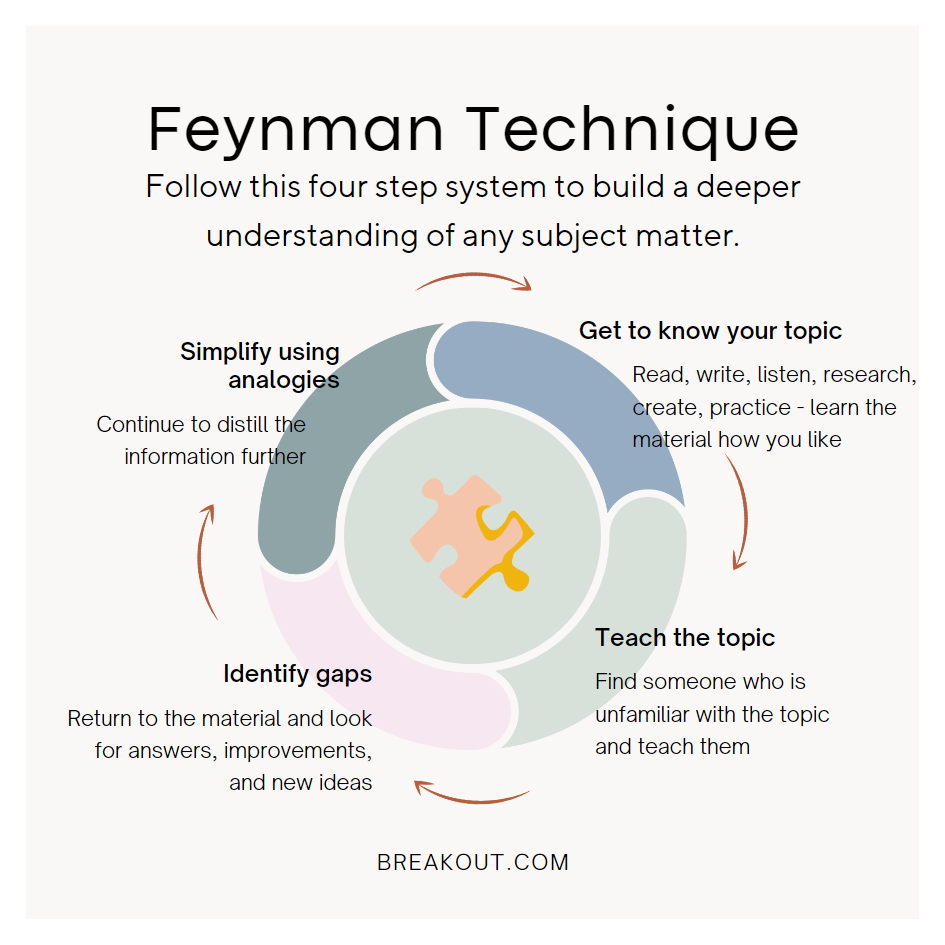Unlocking the Feynman Technique as an Active Learning Tool
As a nursing instructor, you know it can be challenging to help your students learn complex concepts. Of course, you want them to understand the material thoroughly, but knowing how to present it best can be difficult.
The Feynman Technique is a learning method that can help your students master complex concepts. Developed by Nobel Prize-winning physicist Richard Feynman, the technique involves four steps.
Identify the concept you want to learn.
Write down everything you know about the concept.
Try to explain the concept to someone who knows nothing about it.
Identify any areas where you are still struggling and fill the gaps.
Where we struggle
One of the critiques of our higher education system is that it rewards short bursts of memory recall rather than a deep, nuanced understanding of the material. As a result, students will study “hard” before an exam, which typically means sacrificing their physical and mental well-being for the short term and powering through reading, notes, and a few practice questions. But once they encounter a similar problem at the bedside, they cannot recall the information or apply what they previously learned.
Another common assessment by educators is that students do not know “how” to study. Although it may seem fundamental, it is not typically taught to young students. And then, by the time they are adults, they are not using effective techniques.
As nursing instructors, there are many beneficial study techniques - some environmental such as creating a distraction-free zone and using the Pomodoro technique. There are also skill-based techniques such as interleaving and retrieval practice.
🎯This article will highlight a study technique, and you can use it in class as a short active learning lesson. But once students have been through it, it can be a powerful study tool as they prepare for their exams.
History of a study technique
Richard Feynman was a Nobel prize-winning physicist who pioneered quantum computing and introduced nanotechnology. Typically I am not interested in history, but Richard Feynman’s story is fascinating because I love to explore how other people learn. Throughout his career, he studied his own learning process. He considered himself “an ordinary person who studied hard” and believed that anyone could learn even the most complex subjects.
His most popular learning technique is The Feynman Technique, the four-step process listed above that can expand knowledge or a skillset and then go deeper toward genuinely understanding it. The premise is that a student will explain a concept in simple terms so that they can understand it better. In being able to distill the topic to a simplistic idea, it forces students to confront their own understanding and identify areas where they might be lacking. By using this technique, students can gain a deeper understanding of even the most complex topics.
Example
Start by applying the Feynman technique to a learning objective, such as a concept in your fluid and electrolyte lesson. To start, be sure that the concept is clearly defined. For example, fluid balance is a bit broad. Narrow the focus to fluid volume deficit related to blood loss. Next, give students a set time (5-10 minutes) to learn as much about this topic as possible from whatever sources they prefer. Sources may include textbooks, notes, lecture recordings, YouTube videos, or assignments.
Next, ask students to teach the concept to someone unfamiliar with the information, either by explaining it out loud or in a written paragraph.
👩🎓👨🎓In class - assign a different topic to each student in a group.
👩🎓If studying alone - This someone does not need to be a peer, and it is most beneficial if the person does not understand the topic. It can even be an imaginary person or a pet.
The key to this step is reflection. Without shame or guilt, students should ask themselves where they struggled to explain or simplify. It is vital to question themselves without judgment or a sense of failure, discover gaps in their knowledge, and identify new areas to research.
Third, go back to the learning material and review it again, ensuring to fill the identified gaps. This step is crucial because it builds solid foundational knowledge. Like building a house, the foundation is essential.
The final step is to distill the information as far as possible. Simplify the concept, streamline and rewrite notes into the most simplistic version, and clarify the topic to the point that it seems obvious.
After clarifying the topic, ask students to come up with an analogy. When learning new information, comparing it to something we already know and understand is helpful. Use analogies that feel intuitive. Our brains are predisposed to understand complexities through symbolism. When students can connect new and old information, it helps them learn more effectively and retain information for longer.
I went through this process when writing this article. First, I set my Pomodoro timer for one session and researched through articles, textbooks, and a video. I kept notes the entire time. Then, I explained it to my dog (her name is Sisu), and she gave me a rave review. But I had difficulty coming up with an analogy that exemplifies simplification in nursing, so I returned to my materials and looked for a stellar example.
The example I found is deeply engrained in our profession - we use food analogies to describe complex pathophysiology all the time. It is a way to describe an unfamiliar topic by relating it to something familiar. Examples include strawberry tongue, cola-colored jaundice urine, coffee ground emesis.
Final thoughts
The Feynman Technique is especially useful for complex or abstract concepts, encouraging students to break them into more manageable parts. Additionally, teaching the idea to someone else requires you to process and organize the information in a way that makes sense, which can enhance your understanding and memory retention. It is a powerful tool that can help students become better learners and thinkers and work through increasingly complex topics.
Looking for more active learning ideas?
There are many more helpful, practical articles in the Idea Bank.
Ready to get moving with more active learning tools?
I have card decks and classroom kits that are ready-to-go active learning activities that you can implement right away. They are engaging, promote clinical judgment and entice discussion.

